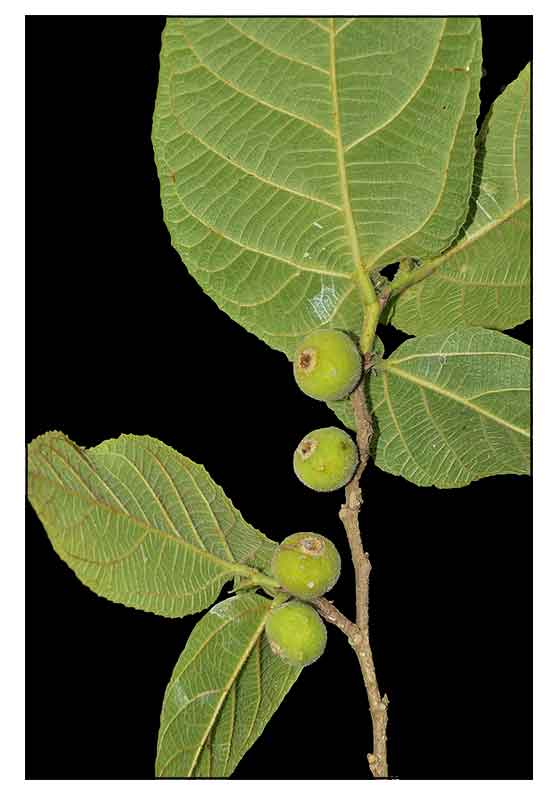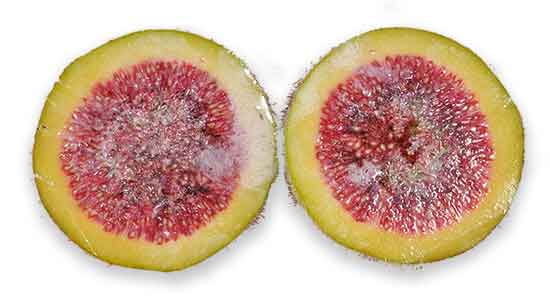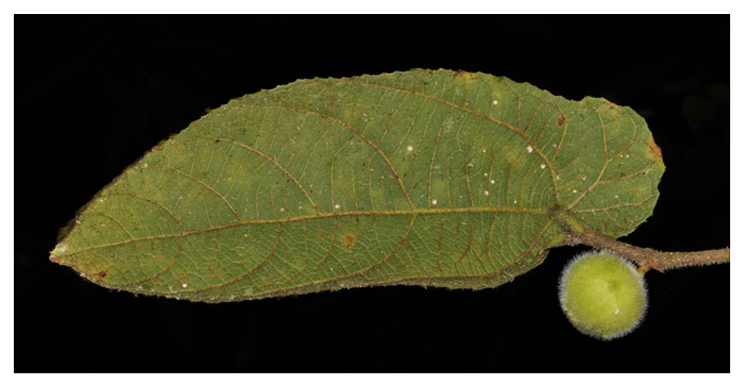 Gen info Gen info
- Ficus is a genus of about 850 species of woody trees, shrubs, vines, epiphytes, and hemiepiphytes in the family Moraceae. They are collectively known as fig trees or figs.
-
There are 150 endemic Ficus species in the Philippines. (4)
Botany
Pakiling is a small tree reaching a height of nine meters, with young hispidous, greenish branchlets. Leaves are simple, alternate, oblong or broadly ovate and rounded, 16 to 20 centimeters long, 6 to 8 centimeters wide, acuminate at the apex, cordately inequilateral, margins toothed, lateral veins 6 to 8 pairs, prominent underneath, base penta- to octa-veined, venation semi-craspedodromous. Young branches are greenish, pubescent, petiole 1.0 to 1.2 centimeters long. (4)
Distribution
- Endemic in the Philippines.
- Widely cultivated in Tayabas, Zambales, Pampanga, Bataan, and Laguna in Luzon.
Constituents
- Dichlormethane extract of leaves yielded l -sitosteryl-3ß-glucopyranoside-6'- O-palmitate (1), squalene (2), lutein ( 3), α-amyrin acetate ( 4), lupeol acetate ( 5), and ß-carotene ( 6). (See study below) (2)
 - Phytochemical screening yielded terpenes, glycosides, and phenolic acids.
Crude extract yielded low gallic acid and quercetin equivalence. (3) - Phytochemical screening yielded terpenes, glycosides, and phenolic acids.
Crude extract yielded low gallic acid and quercetin equivalence. (3)
- Nutrient analysis of leaf for major dietary components yielded 47.5% carbohydrates and 36.1% dietary fibers, 15.2% total proteins, and 4.7% total fat. Micronutrients present were calcium (3.35%), potassium (1.38%), with trace amounts of sodium and zinc. (see study below) (8)
Properties
- Dried leaves are fragrant.
- Studies suggest prooxidant, cytotoxic, genotoxic properties.
- Studies suggest hypoglycemic, antioxidant, hypoglycemic, anticancer properties.
 Uses Uses
Edibility
- Fruit is edible, but variously described as lacking in taste, sweet, or acrid (mapakla).
Folkloric
- Used by the Aetas of Bataan for treatment of various ailments, such as diabetes, cancer, tumor, allergy, asthma, and diarrhea. (8)
Studies
• Cytotoxicity / Human Stomach Adenocarcinoma Cell Line / Leaves:
Study of dichlormethane extract of leaves
yielded 6 compounds. Compound 1
(l -sitosteryl3ß-glucopyranoside-6'- O-palmitate) showed cytotoxicity against human stomach adenocarcinoma cell line (AGS) with 60.28% growth inhibition. (See constituents above) (2)
• Teratogenicity: Study of investigated leaf extracts of Ficus odorata (Blanco) Merr. and Baccaurea tetrandra (Baill) for teratogenic/antiteratogenic potential in inbred strain of ICR mice. Results showed a strong potential for F. odorata, with a high frequency of congenital abnormalities in the fetuses of mice treated with crude leaf extracts. Both plants did not show antiteratogenic activity. (3)
• Pro-Oxidant Activity: Study evaluated F. odorata for potential medical application for its pro-oxidant activity. Pro-oxidant activity was evident in the crude ethanolic leaf extract. Results suggest F. odorata can be tapped as functional food and nutraceutical and drug development. (4)
• Cytotoxic / Genotoxic / Human Hepatocellular Carcinoma / Leaves: Study evaluated Ficus odorata as a chemopreventive agent. Results showed a crude ethanolic extract has potent cytotoxicity towards HepG2 cells. It also showed genotoxic activity by Comet and TUNEL assays. The extract induced release of caspase 3 protease which activates cell apoptosis. Results suggest a potential anticancer agent. (5)
• Hypoglycemic / Antioxidant / Leaves: Study evaluated the hypoglycemic and antioxidant activity of leaves of Ficus odorata. A dichlormethane fraction exhibited scavenging activity against hydroxyl radical and hydrogen peroxide. In STZ-induced diabetic rats, there was significant decrease in mean blood sugar after a 14-day treatment. On toxicity study, it was non toxic up to 2000 mg/kg. (7)
• Prebiotic Potential: Nutritional analysis showed F. odorota is a fiber-rich food ingredient with a wide range of health benefits. F. odorata has potential as functional food component as prebiotics for probiotics. (see constituents above) (8)
• Antibacterial /
Leaves: Study evaluated the antibacterial potential of Ficus odorata leaves against different gastrointestinal bacteria i.e., B. subtilis, E. coli, S. aureus, and S. marcescens. (9)
• Effect on Growth of Lactobacillus salivarius from Filipino Breast Milk: Study evaluated L. salivarius subsp. salicinius JCM 1042, an identified strain from the breast milk of Filipino women, with a 16S rRNA gene exhibiting 99% similarity to L. salivarius CECT 5713, a probiotic in gastrointestinal modulation and immunoregulation. F. odorata may have possible immunoregulatory effects that suggest prebiotic capabilities. F. odorata extract showed no inhibitory activity against the strain, while the strain showed exponential growth in varying extract concentrations. Grown for 24 hours, the bacterial strain thrived best at pH 5.52 at 37°C in modified MRS broth containing 5 mg/ml F. odorata crude ethanolic leaf extract. (10)
• α-Glucosidase Inhibitory / Antioxidant: Study evaluated three endemic Ficus species for antioxidant and α-glucosidase activity. In FRAP assay, Ficus odorata exhibited ferric reducing antioxidant activity relative to ascorbic acid. For α-glucosidase inhibition, Ficus odorata showed enzyme inhibitory effect with IC50 of 1.808 ± 0.21, compared to standard acarbose with IC50 value of 0.621±0.567. (11)
Availability
- Wild-crafted. |

![]()






